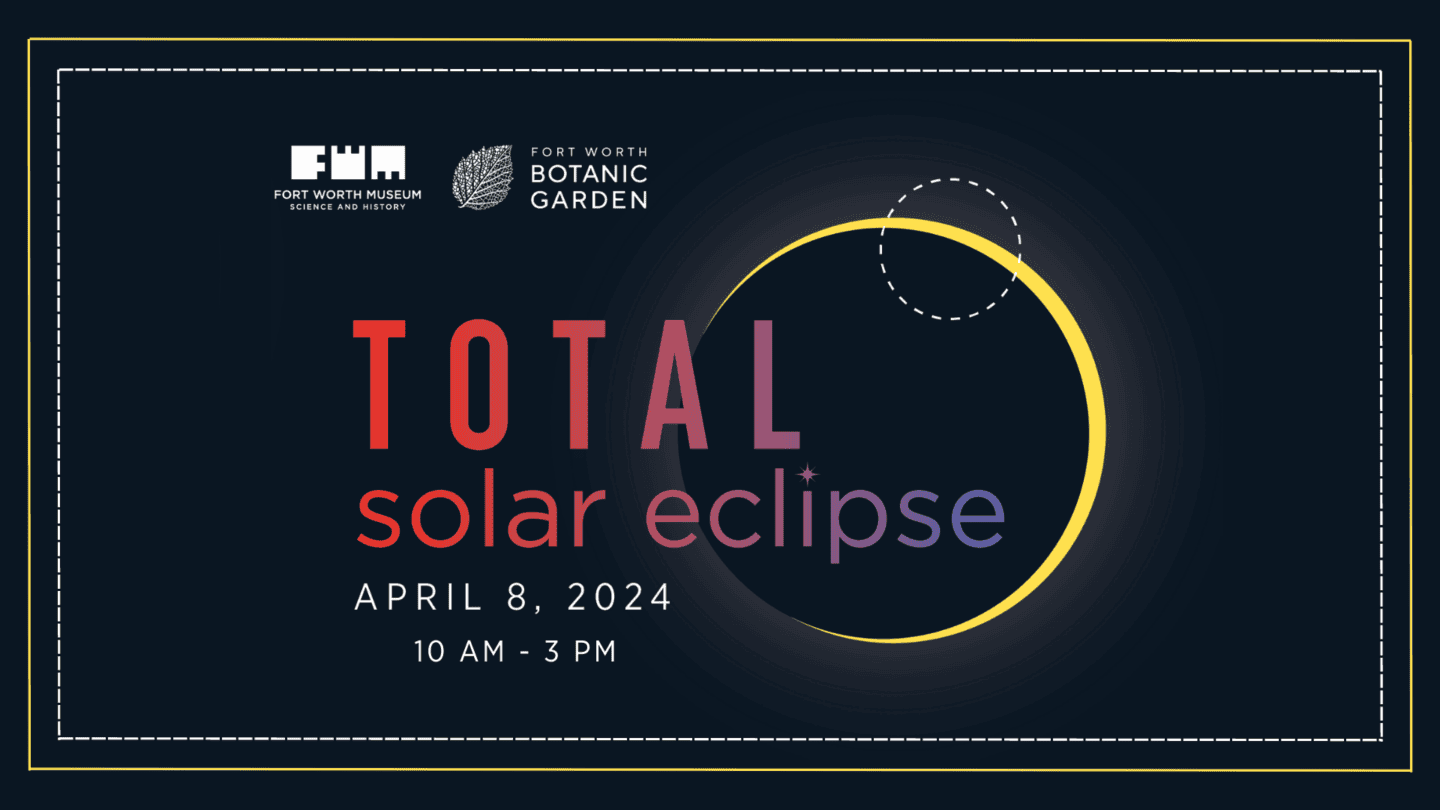Experience History at the Botanic Garden and Museum of Science and History
The Fort Worth Botanic Garden and the Fort Worth Museum of Science and History are partnering for a once-in-a-lifetime solar eclipse experience! Both venues will offer eclipse viewing areas and exciting educational activities for guests on April 8, from 10 AM to 3 PM. Free activity stations will be located outside both the Garden and the Museum, while guests may also purchase general admission tickets at either venue to take part in additional activities. FWBG and FWMSH Members will receive reciprocal free admission and free solar eclipse glasses at each location.
“People in Fort Worth will talk about where they were during this eclipse for years to come,” said Patrick Newman, President and CEO of the Fort Worth Botanic Garden. “The Garden is thrilled to provide a backdrop for this monumental experience. The Botanical Research Institute of Texas (BRIT), the research and conservation branch of the Garden, will also carry out key research into how solar eclipses affect plants and wildlife.”
Guests who choose to view the eclipse from inside the Garden will be able to gather at the expansive North and South Vistas, which offer unobstructed views of the sky. Prime eclipse viewing will also take place on the Museum’s front lawn. Blankets and folding chairs will be allowed. To view the eclipse, guests may bring solar eclipse glasses or purchase them for $3 at either venue. Both venues encourage guests to follow NASA Eclipse Safety guidelines during the events.
Some of the Garden’s activities will include Sun Song Bingo, Pinhole Viewer Construction, Community Science with Members of FWBG’s Research Team, and Shadow Tracing. Lighthouse for the Blind of Fort Worth will also have special activities available at the Garden for visually impaired guests. The Museum will have staff from the Noble Planetarium sharing information about the eclipse and will feature a performance from the U.S. Navy Band Brass Quintet before and after the moment of totality. Guests are invited to build a Pinhole Eclipse Viewer, create a Sun Print, make an Astronaut souvenir, participate in Sunshine Shenanigans, explore the eclipse with Chalk Art, and more.
“The Fort Worth Museum of Science and History is thrilled to invite the community to witness the awe-inspiring beauty of a total solar eclipse. Nature’s grandeur is on full display, and we are honored to be part of this rare cosmic event,” said museum President Regina Faden, Ph.D. “We are excited to share the spirit of exploration and discovery that defines our museum with everyone in Fort Worth and beyond.”
A solar eclipse occurs when the Moon crosses directly between the Earth and the Sun, blocking some or all the Sun’s light. Solar eclipses happen on Earth two to five times a year, and total solar eclipses happen on average every 18 months. So, if total solar eclipses are not so rare, why has Fort Worth not seen one since July 29, 1878? This is because total solar eclipses only recur in one given place within the span of 360 to 410 years. Fort Worth will be in the path of totality, the point of the eclipse where the Moon fully covers the Sun to produce total darkness, for two and a half minutes starting at 1:41 p.m.
Both the Fort Worth Botanic Garden and the Fort Worth Museum of Science and History are official NSTA/SSI Solar Eclipse Partners. The Museum’s work is supported by the Simons Foundation and is part of its ‘In the Path of Totality’ initiative.
About the Fort Worth Botanic Garden
The Fort Worth Botanic Garden is the oldest public botanic garden in Texas with beautiful theme gardens, including the Rose Garden and Japanese Garden, the Adelaide Polk Fuller Garden featuring a comprehensive collection of trees, shrubs, and perennials, and the Victor and Cleyone Tinsley Garden, highlighting plants native to north central Texas. In addition to stunning horticultural displays, the Garden also offers community education for adults, children and families, and international research conducted through the Botanical Research Institute of Texas (BRIT®). The BRIT Philecology Herbarium contains nearly 1.5 million plant specimens from around the world making it one of the largest herbaria in the United States, and the BRIT Research Library houses nearly 125,000 volumes of botanical books and journals. The BRIT Press publishes botanical-related books and the esteemed, peer-reviewed journal JBRIT. The combined campus comprises 120 acres in Fort Worth’s Cultural District two miles west of downtown Fort Worth at 3220 Botanic Garden Blvd., Fort Worth, Texas 76107.
Fort Worth Botanic Garden Media Contact
Dena Lewis | Public Relations Manager
dlewis@fwbg.org | O: 817.463.4188 | C: 512.944.4226
The Fort Worth Museum of Science and History, a distinguished institution established in 1941, is accredited by the American Alliance of Museums and proudly holds Affiliate status with the Smithsonian Institute. Anchored by a diverse and enriching collection spanning science and history, the museum is committed to lifelong learning. Engaging visitors through vibrant programs and exhibits, it interprets the rich tapestry of Texas and the Southwest. The museum’s commitment to education is reflected in its innovative programs, designed to inspire and educate learners of all ages. From interactive workshops to immersive exhibits, the museum provides a dynamic environment for curiosity and intellectual growth. For more information about educational programs, exhibits, and events, visit www.fwmuseum.org.
###

